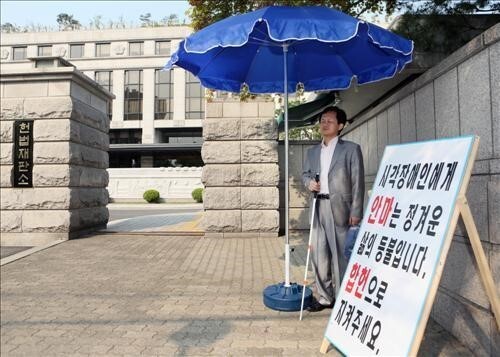hankyoreh
Links to other country sites 다른 나라 사이트 링크
The Constitutional Court’s hypocrisy on one-person demonstrations

By Noh Hyun-woong, staff reporter
The Constitutional Court in Seoul’s Jongno District has a parasol set up outside so that protestors have somewhere to stay out of the sun. Court president Park Han-chul, who formerly headed the public security division at the Supreme Prosecutors’ Office, drew major attention when he ordered it to be put up in May 2013, a month after he took office. It seemed a fitting gesture of consideration by an institution that is supposed to serve as a bulwark of human rights.
But now the court’s guidelines on responding to individual protestors are raising questions about what its attitude toward them really is.
On Sept. 1, the Hankyoreh acquired the Constitutional Court’s “response manual for handling one-person demonstrations” through the office of Justice Party lawmaker Seo Gi-ho, a member of the National Assembly Legislation and Judiciary Committee. The manual sets out step-by-step response measures, including police reporting, for what it presents as unrealistic pressure tactics against a constitutional agency.
“One-person demonstrations may have a negative effect on trust in the Constitutional Court and the authority of trials,” the manual states.
“The frequent one-person demonstrations taking place at the Constitutional Court entrance should be nipped in the bud and prevented from exerting a negative influence on the court’s image,” it goes on to state as its purpose.
Describing the characteristics of individual protestors, the manual says, “There is a tendency for people to resort to unconventional means, such as openly criticizing courts and judges through one-person demonstrations, when it becomes impossible for them to achieve their goals through conventional legal means.”
One reason given by the manual for this approach by protestors is “a lack of understanding about the principles of court independence and legal procedures” - suggesting the court sees protests largely as unrealistic pleading by people ignorant of actual legal procedures.
That perspective is being reflected in the response guidelines. The Court lists three types of protestors - short-term, long-term, and “variant” - and states that long-term protestors should be met with “observation without response, while being made to understand that their problems cannot be solved through such protests.”
Continued monitoring is also advised for the long-term protestors. “In many cases,” the manual advises, “[individuals] suffer from a persecution complex or invest the meaning of their life in one-person demonstrations and expressions of discontent against the Court.”
Response guidelines are also given for “variant forms” such as relay demonstrations, including “collecting photographic evidence of the site and any props, including picket signs, photographs, and banners,” and “reporting demonstrators to the presiding police agency after two warnings if any infringements of legal benefits and protectors are determined to have taken place.”
Previously, the Constitutional Court addressed the controversial Act on Assemblies on Demonstration by declaring, “guarantees on the freedom to demonstrate are a constitutional decision for an open and pluralistic society of tolerance and the coexistence of different opinions.”
“If demonstrations are banished to places where no one can hear them, then the freedom to demonstrate effectively loses its validity,” the court argued.
Please direct questions or comments to [english@hani.co.kr]

Editorial・opinion
![[Column] Season 2 of special prosecutor probe may be coming to Korea soon [Column] Season 2 of special prosecutor probe may be coming to Korea soon](https://flexible.img.hani.co.kr/flexible/normal/500/300/imgdb/original/2024/0426/3317141030699447.jpg) [Column] Season 2 of special prosecutor probe may be coming to Korea soon
[Column] Season 2 of special prosecutor probe may be coming to Korea soon![[Column] Park Geun-hye déjà vu in Yoon Suk-yeol [Column] Park Geun-hye déjà vu in Yoon Suk-yeol](https://flexible.img.hani.co.kr/flexible/normal/500/300/imgdb/original/2024/0424/651713945113788.jpg) [Column] Park Geun-hye déjà vu in Yoon Suk-yeol
[Column] Park Geun-hye déjà vu in Yoon Suk-yeol- [Editorial] New weight of N. Korea’s nuclear threats makes dialogue all the more urgent
- [Guest essay] The real reason Korea’s new right wants to dub Rhee a founding father
- [Column] ‘Choson’: Is it time we start referring to N. Korea in its own terms?
- [Editorial] Japan’s rewriting of history with Korea has gone too far
- [Column] The president’s questionable capacity for dialogue
- [Column] Are chaebol firms just pizza pies for families to divvy up as they please?
- [Column] Has Korea, too, crossed the Rubicon on China?
- [Correspondent’s column] In Japan’s alliance with US, echoes of its past alliances with UK
Most viewed articles
- 1‘We must say no’: Seoul defense chief on Korean, USFK involvement in hypothetical Taiwan crisis
- 2Is Japan about to snatch control of Line messenger from Korea’s Naver?
- 3[Editorial] Korea’s surprise Q1 growth requires objective assessment, not blind fanfare
- 4Division commander ordered troops to enter raging flood waters before Marine died, survivor says
- 5No good, very bad game for Korea puts it out of Olympics for first time since 1988
- 6Korea’s 1.3% growth in Q1 signals ‘textbook’ return to growth, says government
- 7[Reportage] On US campuses, student risk arrest as they call for divestment from Israel
- 8N. Korean delegation’s trip to Iran shows how Pyongyang is leveraging ties with Moscow
- 9Flying “new right” flag, Korea’s Yoon Suk-yeol charges toward ideological rule
- 10[Column] Park Geun-hye déjà vu in Yoon Suk-yeol